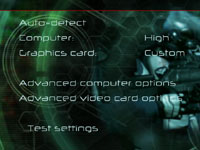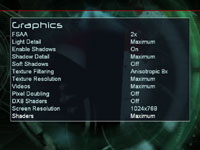F.E.A.R.
Publisher: VU GamesWe used the full retail version of F.E.A.R. patched to version 1.06. The game makes use of a lot of effects - including soft shadows, volumetric lighting, parallax mapping and particle effects, along with a slow-motion mode that really taxes today's top of the line GPU's. There's extensive use of high resolution textures. The walls are both bump mapped and parallax mapped to give a realistic feel to the brick walls that are a big feature of this title. Also, the world is incredibly destructible, which is made more realistic by parallax mapping.
In general, this is a graphically intense game and the most outstanding part of the graphics engine is undoubtedly the player character's shadow that is cast on the wall.
It also has the most advanced A.I. that we have ever seen in a game engine to date - there are times when you'll find yourself with your pants down around your ankles with no where to go. For anyone who hasn't bought this game yet, we highly recommend you do - check out our full review here.
We did a manual run-through from the "Heavy Resistance" level, between two save game checkpoints - it was a section of intense outdoor gameplay that lasted around three and a half minutes. We recorded frame over time graphs for all of our manual run-throughs because we found that the SloMo mode dropped our frame rates in to the low teens. We suspect this drop is part of Monolith's technique for slowing down the gameplay, as the game was not as jerky as the frame rate suggests.
Anti-aliasing and anisotropic filtering were controlled from inside the game, and thus drivers were left set to "Application Controlled".


After witnessing the tearing problems, we came out of F.E.A.R, fired up Quake 4 to inspect if the problems affected other titles. There was no apparent tearing in Quake 4, so we returned to F.E.A.R. 10 minutes later, without any tearing issues. There are four G71 GPUs, the nForce4 SLI X16 Intel Edition south bridge and a Creative X-Fi Fatal1ty FPS all in close proximity with a single 120mm fan cooling them. On further investigation, the bottom area of the chassis where the two video cards were was pretty warm, so it could be that the GPUs were overheating after extended gaming sessions.
After installing a case fan blowing over the GPUs, we didn't encounter the same tearing problem again. We would certainly recommend decent airflow over the video cards if you're considering Quad SLI, because you are sure to encounter similar problems to the ones that we encountered after a long gaming session.
Aside from the tearing which seems to be related to less-than-stellar case cooling, performance was noticeably better on the pair of GeForce 7950 GX2's running in Quad SLI. Much like Quake 4, we were able to increase the anti-aliasing from 2x to 4x and enable transparency multisampling to further improve the level of immersion.

MSI MPG Velox 100R Chassis Review
October 14 2021 | 15:04












Want to comment? Please log in.